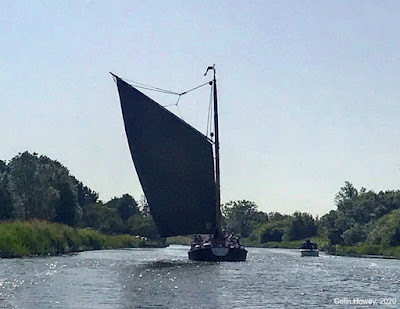Earlier today (Tuesday 17th March, 2020 – regrettably, our last meeting for the while, so long as the Coronavirus threat persists) club members listened to a fascinating talk about the Norfolk wherries by club member and river dweller, Martin. At the end of this, I mentioned a mid-14th century record about the sinking of a ‘keel’ (the medieval predecessor of the wherry).
Now that our face-to-face meetings are
suspended, I have decided to try and post some material here so that folk can continue
to learn about our history. I therefore thought it appropriate to start with
the aforementioned inquest (taken from ‘The Records of the City of Norwich’ by
Hudson & Tingay, 1906).
‘Inquest on Persons drowned at Cantley, 1343
Concerning those drowned near Cantele [modern-day, ‘Cantley’]
It chanced one the night of Sunday next after the feast of
St Luke Evangelist in the 17th year of the reign of King Edward the
3rd (19th October, 1343) […] that a certain boat called Blitheburghesbot [‘Blythburgh’s Boat’] loaded
with men and goods coming from Great Yarmouth to Norwich sank near Cantele in
the King’s river called Wensom belonging to the City of Norwich. On hearing
which Thomas de Morlee, Coroner of the lord King for the City of Norwich, Roger
Verly and Richard de Bitering, Bailiffs of the said City came to the said place
belonging to the City of Norwich on Monday next following and made inquest concerning
the same, as follows:
Inquest held in the suburb of the
City of Norwich in the King’s river which is called Wensom belonging of old to
the liberty of the said City outside Conesford near Cantele on Monday […]
before Thomas de Morlee [etc…] and there present by William de Blitheburgh,
John Bullock, Richard the clerk, Richard de Walsingham, Nicholas de Weston,
John son of Hubert de Hakeford, Walter le Messager, John Pauy, John Salle, John
de Brigge, William de Melton and Richard Bayle, jurors of the Leet of Conesford,
to enquire concerning a boat called Blithburghesbot
loaded with divers[e] goods, men and women accidentally sunk in the said river
near Cantele; Who say upon their oath that the said boat was laden with sea coal
of the value of 10s.; salt in gross value, 12d.; 3 barrells of iron called ‘Osmond’,
value 1 mark [‘Osmonds’ were small bars of Swedish iron, imported in barrels,
fourteen barrels making a ‘last’ containing 4,800 lbs of iron ie the boat was
carrying just over 1,000 lb of iron]; 1 quatron of bord called Ringold (ie ‘board’
or timber from Riga, a Hanseatic port in Latvia], value 4s.; onions and
herrings value, 2s.; and with men and women drowned in the river Wensom near
Cantele to the number of 40, which river belongs to the City of Norwich. And
the said sinking happened there on the night of Sunday […] And they say that
the cause of the said misfortune and sinking was from a great rain that fell
that night and the darkness of the night and the great and strong wind and the
immoderate loading of goods and people which the boat could not bear [10 bodies
were recovered…] They say that the nearest neighbours to the said river are
Richard Bullok, Richard le Clerk and William de Melton. And they say that Henry
de Happisburgh and Nicholas Eghe, who were in the boat, escaped alive and gave
the above testimony.’

No comments:
Post a Comment